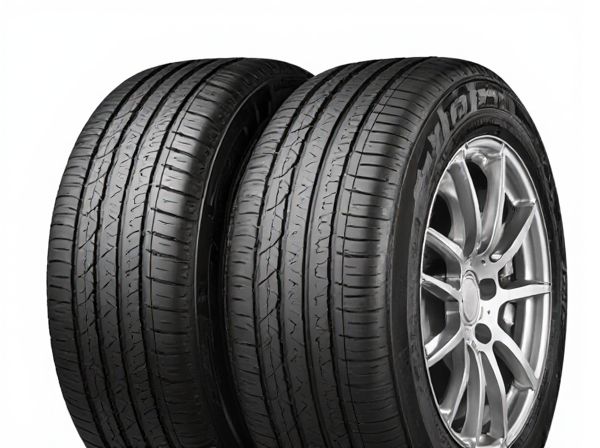
Photo illustration: Energy-Saving Tire vs Performance-Oriented Tire
Energy-saving tires reduce rolling resistance, enhancing fuel efficiency and lowering emissions, making them ideal for eco-conscious drivers. Performance-oriented tires prioritize grip and handling, delivering superior traction and responsiveness for spirited driving or challenging road conditions. Choosing the right tire depends on your driving needs, balancing fuel economy with traction and control.
Table of Comparison
| Feature | Energy-Saving Tire | Performance-Oriented Tire |
|---|---|---|
| Fuel Efficiency | High - reduces rolling resistance, improves gas mileage | Moderate - designed for power, less focus on fuel economy |
| Grip & Handling | Moderate - optimized for everyday driving stability | High - enhanced traction for sporty and aggressive driving |
| Tread Life | Long - built for durability and extended wear | Shorter - softer compounds wear faster under aggressive use |
| Noise Level | Low - engineered for quiet ride | Moderate to High - performance tread patterns may increase road noise |
| Price Range | Moderate - focused on cost-effective efficiency | Higher - premium pricing for advanced performance features |
| Best Use | Daily commuting, long-distance driving, fuel economy priority | Sporty driving, high-speed stability, responsive handling |
Introduction to Energy-Saving vs Performance-Oriented Tires
Energy-saving tires prioritize fuel efficiency by reducing rolling resistance through advanced rubber compounds and tread designs, which lowers energy consumption and carbon emissions. Performance-oriented tires emphasize grip, handling, and responsiveness, utilizing softer compounds and aggressive tread patterns to enhance traction and cornering capabilities. Selecting between these tire types depends on balancing fuel economy with driving dynamics based on individual needs and vehicle specifications.
Defining Energy-Saving Tires: Features and Benefits
Energy-saving tires feature low rolling resistance technology that reduces friction between the tire and the road, thereby enhancing fuel efficiency and lowering greenhouse gas emissions. These tires typically utilize specialized rubber compounds and optimized tread patterns to improve durability and maintain grip under various driving conditions. Benefits include extended tire life, cost savings on fuel, and reduced environmental impact, making them ideal for eco-conscious drivers and long-distance commuting.
Key Attributes of Performance-Oriented Tires
Performance-oriented tires prioritize superior grip, enhanced handling, and high-speed stability, often featuring softer rubber compounds and advanced tread designs to maximize traction on both dry and wet surfaces. These tires typically have reinforced sidewalls and optimized contact patches to improve cornering precision and responsiveness, catering to spirited driving and track conditions. While performance tires sacrifice some tread life and fuel efficiency compared to energy-saving tires, they deliver exceptional driving dynamics and control.
Fuel Efficiency: How Tire Choice Impacts Consumption
Energy-saving tires feature low rolling resistance compounds and optimized tread patterns that reduce friction with the road surface, significantly improving fuel efficiency by lowering the engine's workload. Performance-oriented tires prioritize grip and handling, typically using softer rubber compounds and aggressive tread designs that increase rolling resistance and fuel consumption. Choosing energy-saving tires can reduce fuel consumption by up to 7%, resulting in cost savings and reduced carbon emissions over the vehicle's lifespan.
Traction and Handling Comparison
Energy-saving tires typically feature low rolling resistance compounds and tread designs that enhance fuel efficiency while maintaining adequate traction on wet and dry surfaces. Performance-oriented tires use softer rubber compounds and aggressive tread patterns to maximize grip and cornering precision, delivering superior handling and shorter braking distances. The trade-off is that energy-saving tires may sacrifice some responsiveness and lateral stability compared to the highly responsive traction and dynamic control offered by performance tires.
Durability and Tread Life Differences
Energy-saving tires feature specialized rubber compounds and optimized tread patterns designed to reduce rolling resistance, resulting in enhanced tread life and durability by minimizing heat buildup during driving. Performance-oriented tires prioritize grip and handling, often using softer compounds that wear faster, leading to shorter tread life and reduced overall durability compared to energy-saving models. These differences in material composition and design directly affect the longevity and sustainability of the tire under various driving conditions.
Environmental Impact of Tire Types
Energy-saving tires reduce rolling resistance, leading to lower fuel consumption and decreased greenhouse gas emissions over the tire's lifecycle, making them an eco-friendly choice for reducing carbon footprints. Performance-oriented tires prioritize grip and handling, often resulting in higher rolling resistance, increased fuel consumption, and greater environmental impact due to faster wear and shorter lifespan. Choosing energy-saving tires supports sustainable driving practices by minimizing environmental harm associated with tire production, use, and disposal.
Cost Analysis: Upfront and Long-Term Expenses
Energy-saving tires typically have a higher upfront cost due to advanced materials designed for lower rolling resistance, which reduces fuel consumption and results in significant long-term savings on gasoline expenses. Performance-oriented tires often cost less initially but may wear out faster and decrease fuel efficiency, leading to increased recurring expenses on tire replacement and fuel over time. Evaluating total cost of ownership reveals that energy-saving tires provide better economic value through durability and improved fuel economy despite their higher initial price.
Choosing the Right Tire for Your Driving Needs
Energy-saving tires optimize fuel efficiency by reducing rolling resistance, making them ideal for daily commuting and long highway drives where cost savings and reduced emissions are priorities. Performance-oriented tires emphasize grip, handling, and responsiveness, suited for spirited driving, sports cars, and vehicles requiring enhanced traction in varied conditions. Selecting the right tire depends on your primary driving habits, fuel economy goals, and the level of performance you demand from your vehicle.
Conclusion: Selecting Energy-Saving or Performance-Oriented Tires
Energy-saving tires offer improved fuel efficiency and reduced carbon emissions, making them ideal for environmentally conscious drivers seeking cost savings on fuel. Performance-oriented tires prioritize grip, handling, and speed, thus serving drivers who demand enhanced control and responsiveness under various driving conditions. Choosing between energy-saving and performance-oriented tires depends on balancing fuel economy goals with the need for superior driving dynamics based on individual preferences and driving environments.
 caratoz.com
caratoz.com